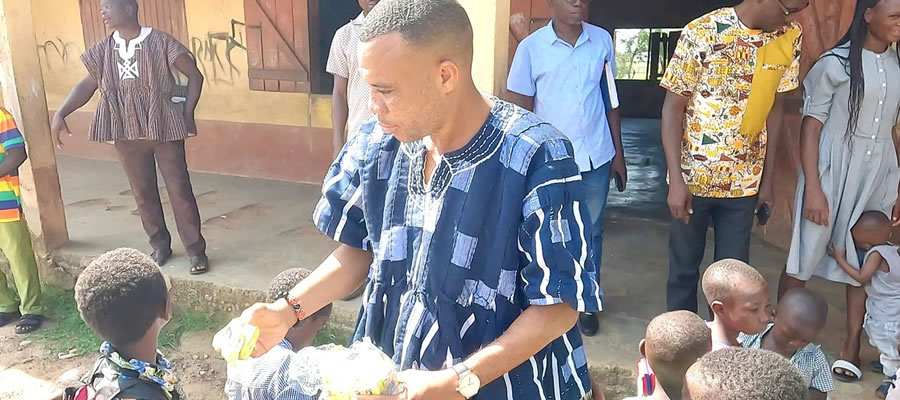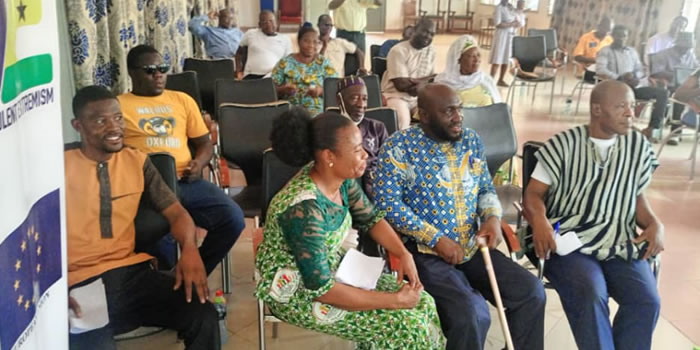

Introduction
This chapter presents an analysis of social characteristics in the KassenaNankana District. Data on household characteristics, marital status, nationality, religious affiliation, literacy and education are presented.
Household Size, Composition and Headship
Table 3.1 shows household size by type of locality. From the table the district has a total household population of 69,967 with 9,792 being urban and 60.173 being rural. The table further indicates that there are a total of 12,813 households with 15.4 per cent in urban areas and 84.6 per cent in rural areas. Again, the average household size in the rural areas (5.5) is slightly higher than the average household size in urban areas (5.0).
Table 3.2 shows household population by composition and sex. The Table shows that, household heads are 18.3 percent of the total household population of KNWD. The table 3.2 further indicates that majority of the household population (47.9%) are children (son/daughter). Spouses (wife/husband) constituted 10.6 percent, grandchildren (6.1%), other relatives (6.2%), brother/sister (4.4%). Parent/parent-in-laws and son/daughter-in-laws are 3.1 percent and 1.4 percent respectively. Step children account for 1.4 percent whiles adopted children/foster children are 0.3 percent constituting the lowest proportion.
More than half (53.8%) of household male population are children (sons), followed by those who are male heads (26.0%), grandchildren (6.4%) and brothers (5.3%). Other male relatives account for 4.2 percent of household male population, male step children 1.5 percent, male parent/parent-in-laws 1.0 percent. Very small proportions of household male population are spouses, son-in-laws, adopted/foster children and non-relative males, accounting for less than one percent each. Of the household female population, like in the case of males, majority (42.2%) are children, followed by spouses (wives) (19.9%), heads (10.8%) and other relatives (8.1%)
.
Table 3.3 presents data on household population by structure and sex. The structure of the household composition refers to the classification of households into categories. Classification of households depends on whether it is a single person household, household that consists of head and spouse only, nuclear household (head, spouse(s) and their children) or nuclear extended among other combinations.
The data indicates that households of the extended family system are the most common in the district constituting 37.8 percent of the household population. The next common category is the nuclear (head, spouse and children) representing 26.1 percent.
There is not much difference between males (12,983) and females (13,465) that live in the extended family households. Single parent extended/ non relative constitute the least proportion of 0.4 percent.
Marital Status
Marriage is one of the institutions in Ghana which is held in high esteem. It is an indicator of one’s social responsibility. It is also one of the determinants of an individual’s social status, trust and achievement. Every adult is expected to marry unless afflicted by serious illness or deformity. In traditional Ghana, voluntary celibacy is not accepted and so frowned upon. Therefore, most adults would wish to get married at one time or the other. This is more peculiar to females.
Table 3.4 shows that more females than males are currently married (48% compared with 44.2%). The proportion of males who have ever married reflects the fact that men are more likely to postpone marriage since traditional practices expect the man to initiate the marriage by preparing the bride price and the responsibility for family maintenance, actions requiring careful and thorough preparation.
There are more males (49.4%) who have never married than females (32.1%). Also, slightly more females (2.5%) than males (2.3%) are have separated. The proportion of females (14.3%), who are widowed, is about seven times that of the males (2.2%).
Table 3.5 shows that the proportion never married generally decreases with higher education; whereas with the married, the proportion declines from 71.1 percent of never attended to 4.5 percent of those with secondary education and then further decreasing to 2.0 percent among those with post-secondary education. The proportion divorced exhibits some differences by education.
The proportion divorced generally declines with increasing level of education such that the proportion divorced among those with higher level of education is about one-third that of their counterparts with no formal education. This pattern is repeated for the widowed. The proportion of the widowed among those with tertiary education is less than one percent.
Table 3.6 provides information on persons 12 years and older by sex, marital status and economic activity status in KassenaNankana West District. Of the total population 48,907 who are 12 years and older in the district, 68.1 percent are employed, 1.6 percent are unemployed and 30.3 percent are economically not active. Married people are in the majority of those employed accounting for 86.6 percent. It is interesting to note that the marital category with the least proportion of unemployed in the district is the widowed constituting only 0.7 compared with those in Informal/Consensual union/Living together which has the highest proportion of the unemployed (7.8%). There are more married males who are employed (89.5%) than married females (84.2%).
Nationality
Table 3.7 presents data on population by nationality and sex. The data indicates the district has a population of 70,667 of which 67,507 are Ghanaians by birth representing 95.5 percent, Ghanaians by dual nationality constitute1.7 percent and ECOWAS nationals form 1.1 percent.
The total male population is 34,747 of which 33,168 are Ghanaians by birth representing 95.5 percent, Dual Nationality constitutes1.7 percent, ECOWAS Nationals 1.2 percent, Africans other than ECOWAS 0.6 percent and Other Nationals constitute 0.5 percent for male.
For the female population of 35,920 95.6 percent are Ghanaians by birth while those with dual nationality constitute 1.8 percent. Only 1.0 percent of the female population are ECOWAS nationals and less than 1.0 percent of Africans other than ECOWAS and other nationals.
Religious Affiliation
The population by religion and sex is presented in Table 3.8. The Table shows that 28.0 percent of the population in the district are Catholics, 30.0 percent are Traditionalist and 12.3 percent belonging to Islam. Population with no religion constitutes 4.1 percent, Protestant (Anglican, Lutheran etc.) 6.8 percent, Pentecostal 13.3 percent and other Christians 4.5 percent.
The male and female populations exhibited different characteristics with 49.7 percent of the male population and 55.2 percent of female population respectively being Christians. About 33.1 percent of the male population are Traditionalist while 28.0 percent of the female population are Traditionalist. The percentage of male population in Islam is 12.2 while 12.3 percent of the female population are Muslims. The data further shows 4.4 percent of the male population have no religion while 3.8 percent of the female population have no religion. The data also reveal that, in the district, 4.1 percent of people have no religion at all. This implies that they are free thinkers.
ICT
Introduction
The use of Information Communications Technologies (ICTs) by individuals and corporate organisations in our daily social and economic life has almost become imperative in this era of rapidly globalizing world that is highly driven by information technology. In Ghana, the recognition of the importance of ICTs is manifested in such actions as the formulation and deployment of institutional and regulatory framework for managing the sector, development of national ICT infrastructure, promotion of the use of ICT in all sectors, implementation of e-governance in all government institutions and the construction of national and regional data centres (Ghana Statistical Service, 2013).
In order to obtain data on the state of ownership and use of ICTs in the district, questions on ownership of mobile phones and use of internet by individuals and ownership of desktop/laptop computers. This chapter looks at the individual ownership of mobile phones, the use of internet among the population aged 12 years and above and ownership of desktop/laptop computers by members of the household by sex of household head.
Use of Internet
Results of the 2010 PHC show that, for the population of 48,907 aged 12 years and older in KNWD, only 1.2 percent use the internet (Table 5.1). This means approximately only one out of every 100 persons of the population aged 12 years and older uses the internet; the number is very low compared to the total population. Of this, the proportion of males is 1.8 percent with a much lower percentage of females, constituting only 0.6 percent.
Household Ownership of Desktop or Laptop Computer
Table 5.2 Presents data on the percentage of male and female headed households having desktop/laptop computers. As shown in the table, out of the total number of households 12,813, only 169 (representing 1.3% of total households) households have desktop/laptop computers with more male headed households (1.5%) having desktop/laptop computers than female headed households (0.9%).
HOUSING CONDITIONS
Introduction
Shelter constitutes constitutes an essential basic need of humankind. The type of dwellings and housing facilities used by a population can be indicative of their general wellbeing and socio-economic status. As a result, the Ghana shared growth and development agenda policy of 2010, recognised the need for increase in access of population to affordable, safe and adequate shelter and housing (NDPC, 2010).
The 2010 population and housing census provided an official count of all structures/dwelling units in the district and collected information on a variety of housing characteristics: the type of dwelling, main house construction materials, occupancy status; waste disposal methods, utilities and household facilities.
The findings of the analyses will help inform housing and human settlement programmes and policy directions, monitor and evaluate housing conditions and needs of the population in the district within the context of MDG7.
Housing Stock
Table 8.1 shows data on housing stock in Ghana, Upper East Region and KNWD. It further shows the housing stock in the district by type of locality (urban-rural). From the table, there are 69,965 persons living in a total of 7,640 residential dwelling units, giving an average figure of 9.2 persons per house. The dwelling units include any type of shelter used as living quarters, such as flats, apartments, enclosed compound, huts, kiosks, cargo containers, and tents.
A total of 12,813 households occupy the 7,640 dwelling units, also giving an average figure of 1.7 households per house with an average household size of 5.5.
Average household size for the region is 5.8, slightly higher than the district figure of 5.5. The district population per house is 9.2 slightly greater than the regional figure of 9.1 and national, 7.1.
In urban areas of the district, there are 9,792 persons living in a total of 1,063 residential dwelling units, giving an average figure of 9.2 persons per house. A total of 1,968 households occupy 1,063 dwelling units. In the rural areas, there are 60,173 persons living in a total of 6,577 residential dwelling units, signifying an average of 9.1 persons per house. A total of 10,845 households occupy the 6,577 dwelling units, averaging 1.9 households per house with an average household size of 5.5.
Type of Dwelling, Holding and Tenancy Arrangement
This section examines the type of dwellings used by households and the associated tenancy arrangements. It focuses on the types of occupied dwellings, ownership status of dwelling by sex of household head and type of locality.
Holding and tenancy arrangement
Table 8.2 shows that in KNWD, most households (92.2%) reside in dwellings owned by a household member. Households that live in dwellings owned by non-household member relatives are 3.0 percent and 2.4 percent live in other private individual dwellings. Households in public dwellings constitute 1.2 percent and purchased dwelling units constitute 1.0 percent. Less than 1.0 percent lives in dwelling units owned by private employers, other private agencies and other ownership type.
Most male headed households in the district (93.0%) reside in dwelling units owned by a household member. Majority of female headed households (90.2%) also live in dwellings owned by a household member. Less male headed households (2.1%) reside in dwellings owned by relatives who are not household members than female headed households (4.9%). Purchased dwellings have equal proportions of male headed and female headed households residing in them. (1.0 percent).
At least three out of four households (75.2%) in urban areas reside in dwellings owned by a household member whereas in rural areas it is 95.3 percent. In urban areas, 10.5 percent of households live in dwellings owned by other private individuals, followed by 7.7 percent in dwellings owned by relatives who are not household members and 3.9 percent in public/government owned dwelling units. However, in the rural areas 2.1 percent of households reside in dwelling units owned by relatives who not household members.
Types of occupied dwelling units
In Table 8.3, data from the 2010 Population and Housing Census indicate that majority of houses in KNWD are compound houses (69.2%). The next most common is separate houses (15.9%) and semi-detached houses (6.0%). Huts/buildings (same compound) constitute 5.8 percent whereas hut/buildings (different compound) form 2.0 percent. Such houses/dwellings as flat/apartments, tent, improvised home (kiosk/container), living quarters attached to office/shop and uncompleted buildings are in the least category accounting for 1.0 percent each.
Of all male headed households, 68.6 percent live in compound houses while for female headed households, it is 70.2 percent. Almost equal proportions of male and female headed households (15.9 percent and 15.7 percent) respectively - live in separate houses. Six percent (6.0%) each of male and female headed households live in semi-detached houses.
Further from the table, in both urban and rural areas of KNWD, compound houses are the most common type of dwelling units, accounting for 72.7 percent and 68.6 percent respectively. While separate houses constitute 12.6 percent in urban dwellings, its proportion in rural area is 16.5 percent.
Construction Materials
This section presents an analysis of the various materials used for outer wall, floor and roof of dwelling units in KNWD.
Materials for outer wall
Majority of dwelling units (85.3%) in KNWD used mud brick/earth as main construction material for outer wall and 12.1 percent used cement blocks/concrete (Table 8.4). Only 1.0 percent used wood. Metal sheet; stone; burnt bricks; landcrete; bamboo; palm leaf/thatch and others account for only one percent each.
In both urban and rural areas of the district, mud brick/earth is the predominantly used construction material for outer walls of both occupied and vacant dwelling units. It accounts for 90.0 percent of all rural dwelling units and more than half (59.2%) of urban dwelling units. After mud brick/earth, the next most used material for outer wall of dwelling units is cement blocks/concrete, used by 7.1 percent of rural dwellings and 39.7 percent of urban dwelling units. The proportion of dwellings using mud brick/earth as main material for outer wall in rural localities is higher probably because mud compared to cement is relatively cheaper and affordable to the presumably poorer rural population.
Materials for floor
Table 8.5 shows the proportions of main construction materials used for the floors of the dwellings in the district. Majority of dwelling units (up to 57.2%) in KNWD use cement/concrete for the construction of the floor of the house, 40.8 percent used earth/mud and very few (0.8%) use ceramic/porcelain/granite/marble tiles.
A total of 0.5 percent used stone and only 0.1 percent used burnt brick.
Comparing the urban and rural figures one can see that the highest proportion of urban dwellings (87.9%) used cement/concrete as the main construction material for the floor, 10.1 percent used earth/mud and 1.3 percent used ceramic/porcelain/granite/marble tiles. In the rural areas, more than half (51.6%) of rural dwelling units used cement/concrete as main material to floor, 46.4 percent used earth/mud, and as low as 0.7 percent used ceramic/porcelain/granite/marble tiles.
Materials for roof
Table 8.6 presents information on main construction material for roofing of dwelling units in KNWD and also in urban and rural localities. The table reveals that metal sheet is the most common material used for roofing houses/dwelling units in the KNWD constituting 46.7 percent of all dwelling units, followed by mud/mud bricks/earth accounting for 45.3 percent and thatch/palm leaf or raffia accounting for 4.0 percent. Dwelling units roofed with wood constitute 2.9 percent and cement/concrete 0.4 percent. Slate/asbestos and bamboo accounts for less than one percent each 0.2 percent used roofing tiles while other materials used for roofing accounts for 0.3 percent.
In urban areas, as high as 81.9 percent of dwelling units are roofed with metal sheet, followed by mud/mud bricks/earth 13.5 percent and thatch/palm leaf or raffia accounting for 3.2 percent . Unlike urban areas, 51.0 percent of rural dwelling units are roofed with mud/mud bricks/earth followed by metal sheet (40.4%) and thatch/palm leaf or raffia (4.2%). Bamboo and slate/asbestos are hardly used in both urban and rural areas, accounting for approximately 0.1 percent of dwellings in the rural areas.
Room Occupancy
Table 8.7 shows different household sizes and the number of rooms they occupy in dwelling units in KNWD. The table shows that there are a total of 12,813 households in the district. Of the total number 17.0 percent live in single rooms, 27.2 percent in two rooms, 25.3 percent in three rooms and 14.9 percent in four rooms.
For one member households, 57.2 percent (highest proportion) occupy one room, 25.2 percent occupy two rooms, and 9.6 percent occupy three rooms and 3.6 percent four rooms. About 30.5 percent of three-member households occupy one room, 37.0 percent live in two rooms and 20.0 percent in three rooms. Generally, the higher the household size, the fewer the number of rooms to as low as 0.2 percent occupancy for single person households living in nine rooms or more.
From the table, households with a size of 10 and above occupying one room are 2.1 and 23.6 percent for four rooms.
Access to Utilities and Household Facilities
This section analyses household amenities, cooking space and sanitation issues in dwelling units in the district by locality.
Sources of lighting
The source of lighting used by households of a population can be indicative of their quality of life in society. Improvements in the standard of living in a society has a direct effect on the quality of source of lighting for the population; the source of non-natural lighting changes from use of low quality sources such as fuel wood to more efficient ones such as electricity.
In the district, as shown in Table 8.8, the three main sources of non-natural lighting in households are kerosene lamp (57.1%), flashlight/torch (26.8%) and electricity (mains) (12.7%). The table also shows other known sources of lighting and proportion of households using them are firewood (1.0%), electricity (private generator) (0.6%), solar energy (0.5%), crop residue (0.4%) and candle and gas lamp (0.2% each).
A comparison of urban and rural proportions of households using the various main sources of lighting shows that the patterns both in rural and urban areas are similar. Majority, (60.8 percent) use kerosene lamps 28.4 percent use flashlight/torch and only 7.0 percent use electricity from the national grid. These are also the main sources for the urban areas although the proportions are higher than those of the rural areas. The proportion of households using electricity is 44.0 percent while kerosene lamp and flashlight/torch constitute 36.6 percent and 17.9 percent respectively. The rural proportion for Kerosene lamp usage is significantly higher than the urban proportion.
Sources of energy for cooking
The three main sources of energy of households for cooking in KNWD are wood (73.3%), charcoal (11.9%), and crop residue (10.5%) as shown in Table 8.9 and Fig. 8.1. About 2.5 percent use gas, 0.3 percent use electricity, 0.2 percent use kerosene and 1.3 percent does not cook. Wood dominates probably because of easy access especially to the rural population (which constitutes a larger proportion of the district’s population).
Households using wood as source of energy for cooking remained significant for both urban and rural areas with proportions of 45.1 percent and 78.4 percent respectively. About 43.4 percent use charcoal in urban areas and 6.2 percent in rural areas. Although charcoal is usually produced in the rural areas, it is mostly sold to urban households and this may account for the low proportion of households using charcoal in rural areas. Crop residue as a source of fuel for cooking accounts for only 0.9 percent in urban areas and 12.3 percent in rural areas. More urban households (7.6%) use gas as main source of cooking fuel than rural households (1.5%).
Types of cooking space
Table 8.9 shows 41.0 percent of households in KNWD use separate room exclusively for cooking, 32.7 percent use open space in compound, 11.1 percent use veranda, 7.9 percent use enclosure without roof and 1.3 use separate room shared with other households. Very small proportions of households use bedroom/hall/living room (0.2%) and structures with roof but without walls (0.6%) as cooking spaces.
For urban and rural areas, whiles majority of urban households (39.3%) use open space in compound for cooking, most rural households (44.9%) use separate room for exclusive use of household. The urban population using veranda as cooking space constitutes 33.1 percent and 7.1 percent in rural areas.
Date Created : 11/21/2017 3:40:24 AM








 facebook
facebook
 twitter
twitter
 Youtube
Youtube
 +233 593 831 280
+233 593 831 280 0800 430 430
0800 430 430 GPS: GE-231-4383
GPS: GE-231-4383 info@ghanadistricts.com
info@ghanadistricts.com Box GP1044, Accra, Ghana
Box GP1044, Accra, Ghana